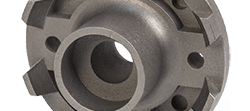Titanium Metal 3D Printing
Get quotes on titanium metal parts. Free shipping on all US orders. ISO 9001:2015, ISO 13485, IATF 16949:2016, and AS9100D certified.

About 3D Printing in Titanium
Titanium metal uses are versatile; it is widely used for medical applications due to its biocompatible composition. Titanium 3D printing is a good option for medical implants as the parts can be made hollow and can feature complex surface geometries that act as attachment points for bone and tissue growth. In addition to this, its excellent strength-to-weight ratio and corrosion resistance make it a popular material in the aerospace industry.
Titanium has a high strength-to-weight ratio, excellent resistance to corrosion, and is also biocompatible. These properties, along with complex part geometries made possible by metal 3D printing, make titanium 3D printing perfect for applications in both the medical and aerospace industries.
DMLS Titanium Ti64
Containing 6% aluminum and 4% vanadium as its alloying elements, Ti64 is the most widely used titanium alloy. This alloy is significantly stronger than commercially pure titanium. In addition to its strength, this alloy has excellent corrosion resistance and is highly biocompatible. Titanium applications include surgical implants and turbine blades.
| Tensile Strength (MPa) | Yield Strength (MPa) | Elongation at Break (%) | Hardness (Brinell) | Density (g/cm^3) |
|---|---|---|---|---|
Tensile Strength (MPa) 1290 ± 50 | Yield Strength (MPa) 1140 ± 50 | Elongation at Break (%) 7 ± 3 | Hardness (Brinell) 304 | Density (g/cm^3) 4.41 |
Finishes
Parts made using titanium 3D printing come out with the same density as those machined using subtractive methods. They can also be machined or polished in the same way. It must be noted that titanium in general can be challenging to machine.
Standard: Standard finishing refers to the removal of any support structures. The surface of the part is also medium blasted to create a uniform appearance.
CNC Machining or Polishing: In some cases, parts may need additional CNC machining or polishing in order to complete specific features on the component. However, these situations are evaluated on a case-by-case basis.

Cost-saving Design Tips
To save money when titanium 3D printing, follow these cost-saving design tips:
DFM: DMLS titanium metal 3D printing can produce high-strength and low-mass functional parts suitable for the most demanding medical and aerospace applications. When designing parts for metal 3D printing make sure that any enclosed areas have holes from which to remove unfused powder after printing.
Support structures should also be considered in the design and final product since DMLS prints generally require these to prevent warping and to support overhangs. In order to learn how to leverage the benefits of titanium 3D printing, consult with a Xometry expert.
